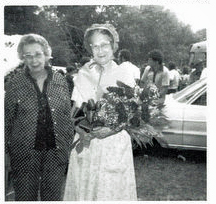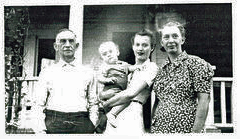| Elma Heim Griffith Memorial Pages By Bob Williamson |
| By Bob Williamson As a child growing up in the Dawson community, the person who was recognized by us all as the local historian and writer of history was Elma Heim Griffith, (April 8, 1903 – August 22, 1979). She was the editor and publisher of several books on the Nebraska Pennsylvania Colony. These books along with the ones written by Melvin Heim and his sister Mary Bilsing are enjoyed nor only for the historical data included but also for the pictorial and descriptive way they wrote. The following article is being included in book, “The Sweet Spring Still Flows”, as a memorial to Elma Heim Griffith and her great writing skills. These notes were found among her things following her passing and kept for their historical significance. For those of you who do not know the Jake Heim Farm, northwest of Dawson, Nebraska, now owned and farmed by Dennis Thacker — you will enjoy the visions of life experienced by all of the Pennsylvania Colonists who lived the life of an early pioneer in the region. Elma writes: I’m going through some of Dad’s papers. We found the deed given by I. H. Burr to Grandpa John J. Heim for the farm where Dad and Mom lived from the time they were married. Grandpa bought the 160 acres in January of 1889 for $5000. Mr. Burr had homesteaded it. Dad farmed this place several years and it was also rented part of the time. Then when the folks were married on March 17, 1892, they set up housekeeping there. None of the buildings on it were good. The house had 3 rooms downstairs. There was also a “lean to” kitchen with a dirt floor. All kinds of people had lived there on the years between and some were none too clean. They strongly suspected it was infested with bedbugs. So. Before the folks moved in the lean-to kitchen was pulled away and became a chicken house. They cleaned the house thoroughly and papered all the rooms carefully and painted woodwork and the wainscoating. There was no cellar under this house. The barns and sheds and lots were all north of the house as was also the windmill and well. The lane from the road was north of the house too. |


| During the earlier days when all was prairie and there were no fences, there were roads or trails going off across country. No one paid any attention to section lines One of these roads angled across this farm, going across the southeast corner of the front yard and and on across the farm toward the south west corner. This trail was still visible in the piece of prairie Dad kept in several acres in the southwest corner of the farm. The prairie grass grew over it by then but the deeper indentation of the old road was still quite plain to see. This, I believe, was known as the Pawnee City-Brownville trail. At the very corner of the farm where the 4 quarters of the section met there was a large buffalo wallow. There was no sign of this anymore except as a low place and rather wet ground where the sumac grew in a big thicket. But I can well imagine the people using this trail stoppig here to water their horses. I believe, O. W. Barr, son of Ike, once told of going swimming in this buffalo wallow. In later years, when I was small, and this spot was a large sumac thicket Dad decided to kill out the sumac or at least make the thicket smaller as it was getting so large and was a nuisance. The cows were sure to be in that thicket when he wanted to round them up and bring them in at milking time. He used an ax and a grubbing hoe (no bulldozer dreamed of then) and as it was a long way from the house he took water along for drinking. One day when he had made quite a lot of headway on the job and the spring weather had warmed up quite a lot, he was at work on it again. All at once here in front of him was a rattlesnake, kind of a lazy one but a rattlesnake none-the-less. He killed it of course. Soon here was another to one side, and a bit later another over here and then here was another. He decided there must have been a rattlesnake den there where they had hibernated over the winter. Soon after that rattlesnakes were rarely seen and now are not found in this part of the state. I don’t believe Dad ever did get the sumac entirely killed over in that corner. Burning the prairie was another story. All this end of the state and extending far west was prairie grass during the days of the Indians. No trees except along rivers and creeks. The Indians wanted it that way as the buffalo was their main source of meat and the prairie was their grazing ground. They knew the only way to keep the prairie grass doing well and to bring on the new tender growth was to burn it off every spring. They set fire to it and acres and acres and miles and miles of prairie were often burned off before the fires were put out by rain or a change of wind. It was a weapon they used on the early settlers too, as they had almost no defense against it. Dad had only a few acres of the original prairie but he liked to keep it only for sentimental sake but it made excellent pasture in the mid summer when the blue grass pasture was eaten or dried off from lack of rain. In spring when the new grass had not started to grow yet, he would take a couple buckets of water and a gunny sack (burlap bag) mop and a pitch fork and go burn the prairie. However, he chose a day when there was no wind or very little, so he could keep it from going into the neighbors fields or into the hedge fences. He always told Mom what he was going to do and many a time she would go to the rise of ground west of the grove where she could see it all was well with the burning. It also happened that sometimes the wind came up or changed direction and Dad had trouble keeping the fire in control and Mom would go down there to help him. It never did get away from them very seriously. Soon after the old grass was burned off the new prairie grass came up in sharp, bright green spears and the wild prairie flowers came too and before long it was a beautiful sight to see the grass waving in billows, dotted here and there with wild flowers. The fire never hurt them in fact it seemed to act as a sort of fertilizer. To this day when ground that has not been plowed is burned off and the bluegrass is killed by the fire, the prairie grass will be as strong and healthy as in the early days. Dad’s wheat and oats were all cut with the binder and stacked in big cone shaped stacks to be threshed in late summer after the grain had gone through a sweat in the stack. Dad was a good grain stacker and rarely did one of his stacks slip out. He was also a good shocker, his grain stacks stood unless we had a very severe wind storm when the cap sheaf was blown off. Then he would go through the fields and repair the wind’s work. Both these, shocking and stacking of grain are now a lost art in this day and age of the combine. The Badger cultivator was an implement he enjoyed using for cultivating corn. None other ever suited him, he said it covered up less small corn. He also liked the check row planter best and it was several years after the lister planter became popular that he consented to its use. As a boy, in Pennsylvania, he knew what it was to cut flax with a hand sickle. But they had progressed to the scythe for cutting hay and the grain cradle for cutting grain and the horse powered threshing machine. He knew how to use the flail and the hand powered threshing that cane earlier. In his life time they went from the hand flail sickle to the tractor powered corn picker and combine. Mama remembered their ox team. “Buck and Bright” used sometimes for plowing but used especially for hauling logs in winter. On November 19, 1895, their first child, Verna Ruby was born. Dr. J. A. Wagner was their doctor and of course she was born at home. No one ever dreamed of going to a hospital for a birth. In fact hospitals were extremely scarce if they existed at all. Certainly they knew nothing of hospitals. The hired girl took care of Mom and the new baby. On April 8, 1903, I, their second and last child was born. Again, Dr. J. A. Wagner was the doctor and I was born at home, too. Verna was 7 ½ years old. Bertha Heim (Shirley) was the hired girl this time. She was Aunt Rosie and Uncle Joe Heim’s oldest daughter. It seems Mom had been looking for a hired girl and just couldn’t find anyone. When Aunt Rosie found it out she said Bertha could come. She hadn’t forgotten the many times Mom had helped out their family before Mom and Dad were married. I don’t remember hearing whether they had such a time finding a name for Verna but it took them 6 months to find a name for me. I guess Mom tried them all out on me. Once she thought Jessie would be the name but she happened to find out that the Henry Heim had a little girl 2 or 3 years old and was being called Jessie. They had been calling her by her middle name, Florence, but had recently changed. It would never do to have 2 Jessie Heims. She would have liked to call me Rosalee but wasn’t sure how to spell it and besides was afraid I would be called Rosy which she didn’t like. How she finally hit on the name of Elma I don’t know but she seemed to like it best of all she had tried out. My middle name of Bertha was given me because the hired girl felt sorta bad when many folks used her sister May’s name for their children. Hence, Elma, Bertha Heim Griffith! THE END |